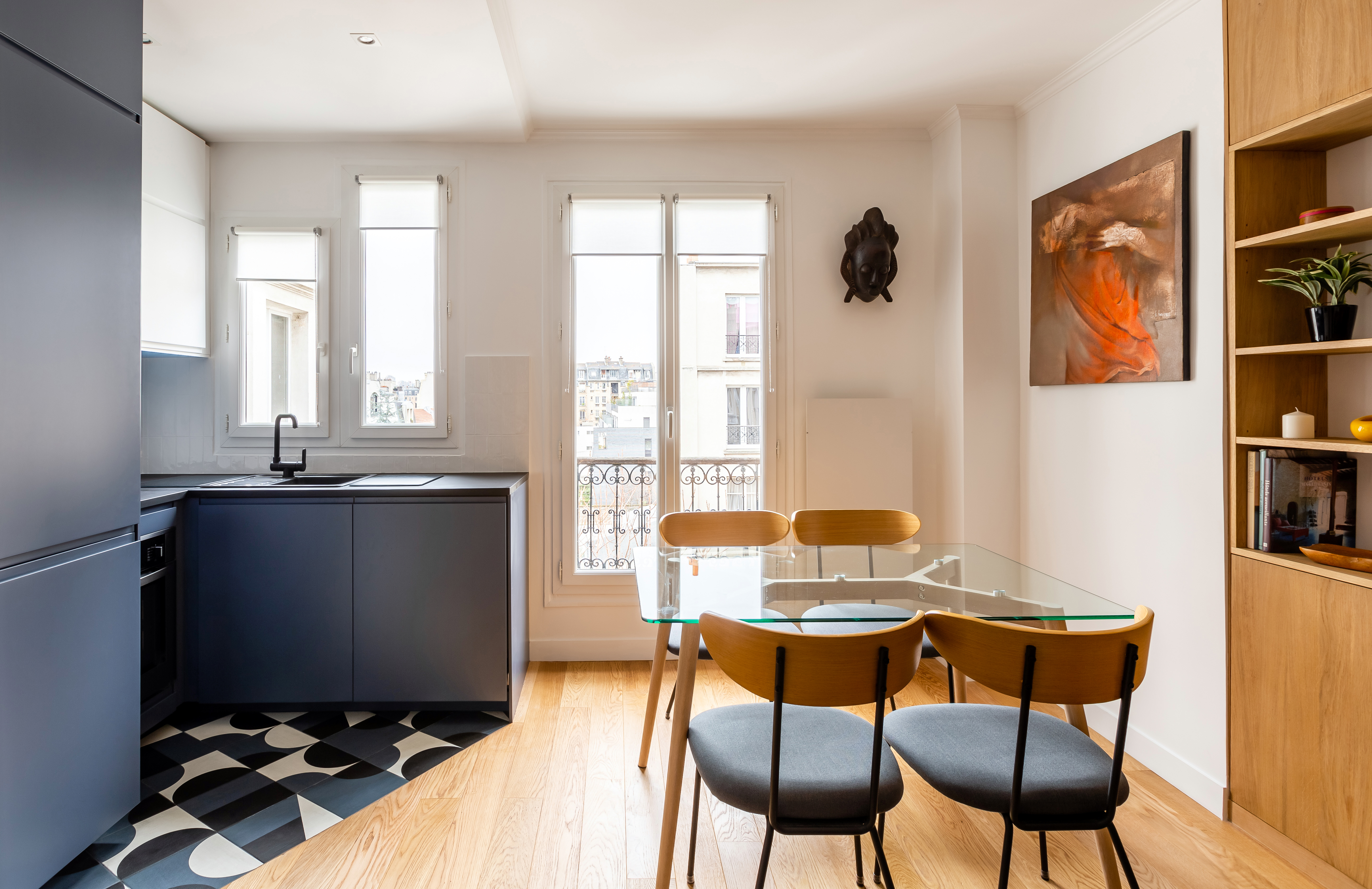
Not all kitchens are built for large, bountiful feasts — but that doesn't mean small kitchens are any less full of potential. Size has no bearing on style, and with smart storage and layout ideas, even the most compact kitchen can be made to work in your favor.
As designers continue to show us, creating a modern kitchen comes down to clever carpentry, concealed cabinets, thoughtful color palettes, and eye-catching hardware. These elements can work wonders in making a small space not only more functional but also visually striking. As the old adage goes, “good things come in small packages,” and these kitchens are proof of that.
So, whether you're looking to give your tiny space a fresh lease on life or are working within tight square footage from the start, these examples offer plenty of inspiration. Bookmark the ones that speak to you most.
1. Hide a Small Kitchen Behind Pocket Doors

Sometimes, a small kitchen can feel like the centre of chaos—dirty dishes, overflowing pots and pans, and rogue cutlery all adding to the visual (and mental) clutter, especially after a long cooking session. If this sounds familiar, it might be time to consider concealing your kitchen entirely. Enter: the pocket door.
Take a cue from this clever setup by Damian and Britt Zunino of Studio DB. Their design not only smartly tucks the kitchen out of sight when needed but also gives it a generous dose of character through color and thoughtful detailing.
“The color palette was anchored around a very specific shade of Prada Mint Green, which the client requested,” they share. “We meticulously matched it to the exact Pantone reference to create a cohesive foundation. From there, the pink pocket door emerged naturally—its playful contrast felt just right, adding a relaxed yet intentional energy to the space.”
2. Go for a U-shaped Kitchen for Efficient Workflow
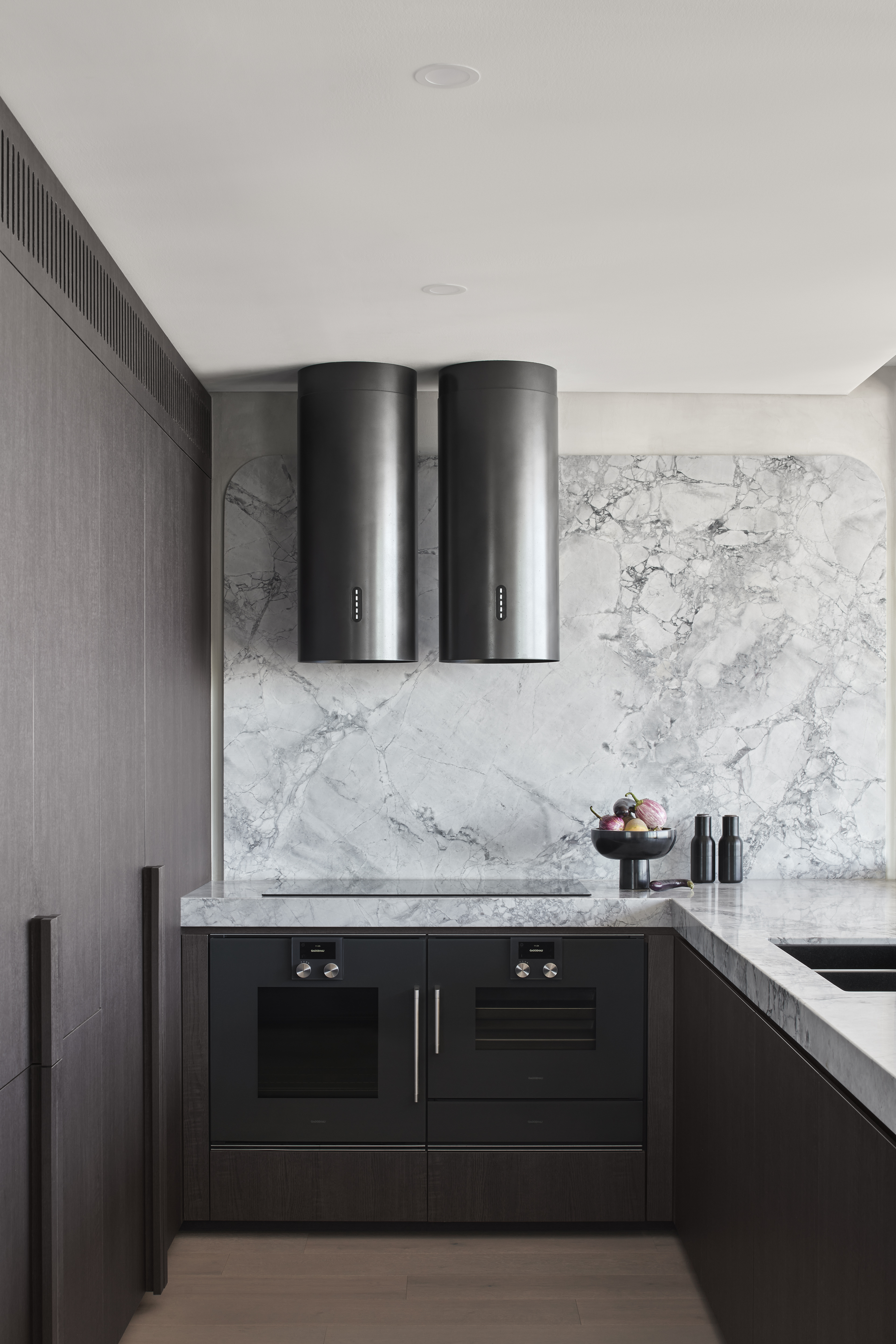
As many of you know, a U-shaped kitchen offers several advantages. This small kitchen layout helps maximize both storage and counter space while also improving workflow. It’s a highly flexible design—especially useful when more than one person is cooking.
"The kitchen’s storage was meticulously crafted to balance aesthetics and functionality," says Richard Misso of the Stylesmiths. "Bespoke walnut timber cabinetry provided ample concealed storage, ensuring a seamless and uncluttered look in this U-shaped space. Integrated appliances and seamless handle design elements maintained a streamlined aesthetic, while rich, natural materials enhanced the warmth and depth of the space. Every detail, from the soft-close drawers to the custom-fitted compartments, reflects a thoughtful approach to organization and accessibility."
What’s more, the U-shaped layout can be easily adapted to suit a range of styles and preferences, from traditional to modern. Interestingly, it can even accommodate an island if space allows.
3. Highlight a Small Cook Space With a Floor Change

More often than not, in a small studio apartment with an open plan, social spaces like the dining or living room end up taking over, leaving the kitchen tucked into a corner, stripped of identity and presence. But it doesn’t have to be that way.
Take this beautiful space by Margaux Carnevali of NEVA Architecture Intérieure, for example. Thanks to the strategic use of small kitchen floor tiles, the compact cooking zone becomes the crown jewel of the room.
“There used to be a wall between the kitchen and living room, which we removed to create a larger living area,” shares Margaux. “We designed the kitchen at an angle to align with the line of small windows and to connect diagonally with the wall’s corner. This visually separates the space from the dining and living areas—no walls, just a defined boundary. The floor does the job here, using tiles chosen for easy cleaning, and though it’s a tiny area, it’s highly graphic—both in the triangular layout and in the pattern of each individual tile.”
4. Take the Storage to the Ceiling

Make your tiny space work harder with smart small kitchen storage ideas. If you’re short on counter space and the walls are already saturated with shelves and cabinets, consider adding storage units above the hood or island, extending them to the ceiling. This helps maximize storage without overwhelming the room visually, since it's all placed above eye level.
“A small breakfast counter marks the kitchen area, anchored by a minimal custom-built bar unit,” says Aishwarya Govind of House of Ruya. “The kitchen was designed purely with the clients’ functional needs in mind. We carried the design language through from the rest of the home to maintain a cohesive, monotone look. While the color scheme remained consistent, we chose different materials in the kitchen to allow for easier maintenance."
"Since the kitchen is part of the main living area, we opted for all closed storage to keep things visually clean. Accommodating multiple client requirements was a challenge, especially the addition of a bar unit. A floor-mounted version would have taken up valuable space, while repurposing existing shelving would have meant sacrificing storage. Our solution? Suspending the bar unit above the island and the hood.”
5. Expand the Workspace With a Peninsula

A great way to add more counter space and storage is with a kitchen peninsula. This smart feature offers a variety of functions: it can serve as an extension of your kitchen countertop, providing extra surface area for prepping, chopping, or even cooking. You can also incorporate storage within the peninsula to tuck away pots, pans, or small appliances. In open-plan homes, a peninsula helps create a subtle yet effective division between the kitchen and living areas without the need for walls.
Beyond function, a peninsula can also become a visual design element that adds personality to the space, perhaps through fluted detailing or a sculptural stone base.
“A black, perforated metal open shelving unit playfully peeks out from beyond the large arched frame of the kitchen entrance, mirrored by a peninsula beneath it, as viewed from the living area,” notes Eric Martin of Picnic Design. “This peninsula is topped with a crisp, bright porcelain slab that completes the kitchen countertop. The base of the peninsula, facing the living area, is wrapped in solid white oak half-round tambour, adding a visually intriguing texture—a sort of pause—before entering the kitchen. A slim strip of window acts as a linear block of light nestled between matte gray laminate overhead cabinets and the sink.”
6. Invest in Good Hardware in a Small Kitchen
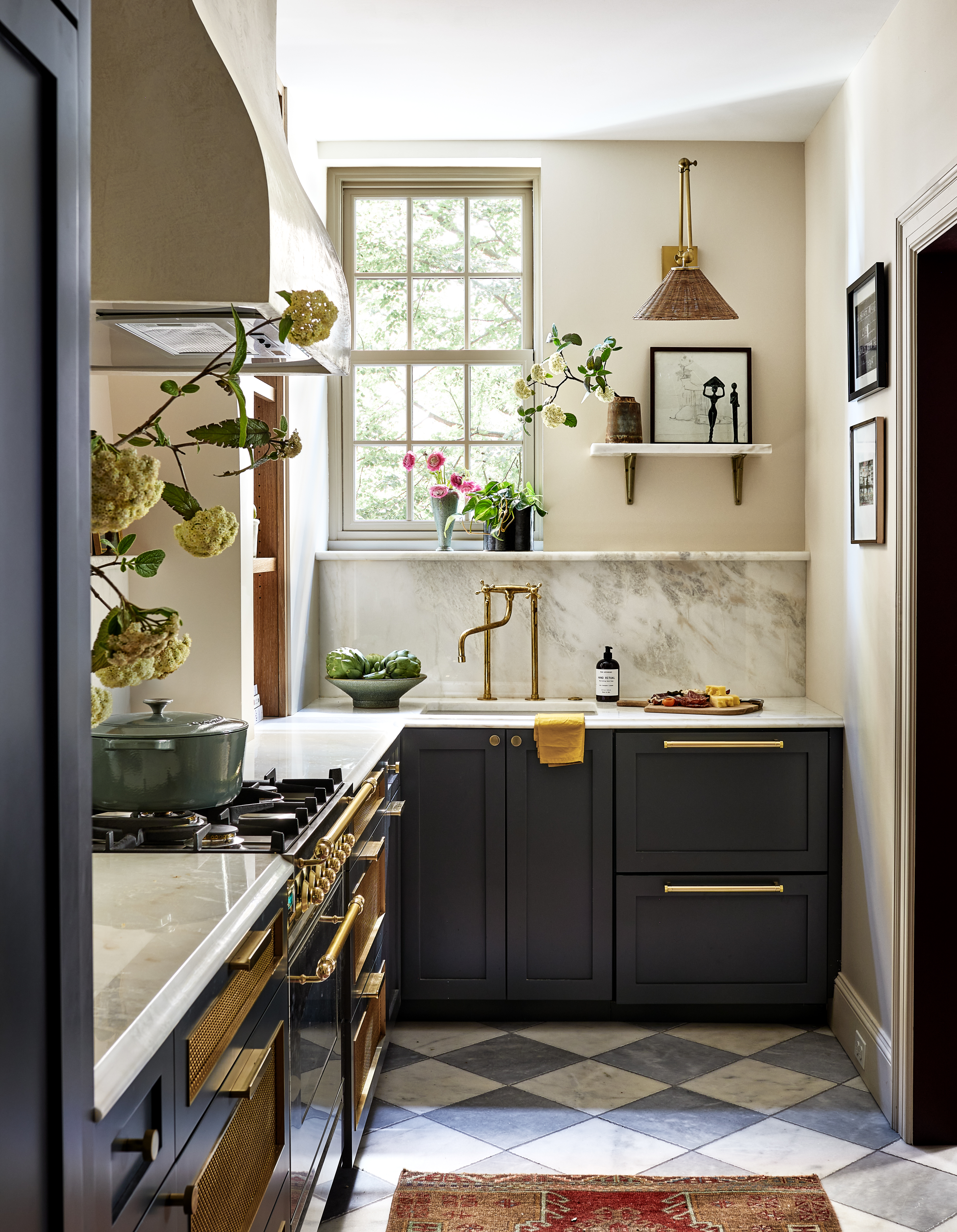
Treat your modern small kitchen like a treasured space—a jewel box. With limited square footage, it's worth investing in a few standout design elements to elevate the room’s overall impact. Just take a look at this kitchen designed by Zoë Feldman of Zoë Feldman Design. In this compact space, the hardware truly shines, beautifully complemented by bold checkerboard flooring.
“This kitchen blends moody elegance with timeless charm,” says Zoë. “Dark cabinetry contrasts with creamy walls and marble surfaces, while checkered flooring adds vintage appeal. Brass hardware and fixtures warm the space, echoing in the range’s detailing. A woven pendant and open shelving introduce texture, creating a refined yet inviting feel.”
Price: £43.99
Material: Solid Brass
7. Consider a One-Wall Kitchen for Enhanced Circulation Space
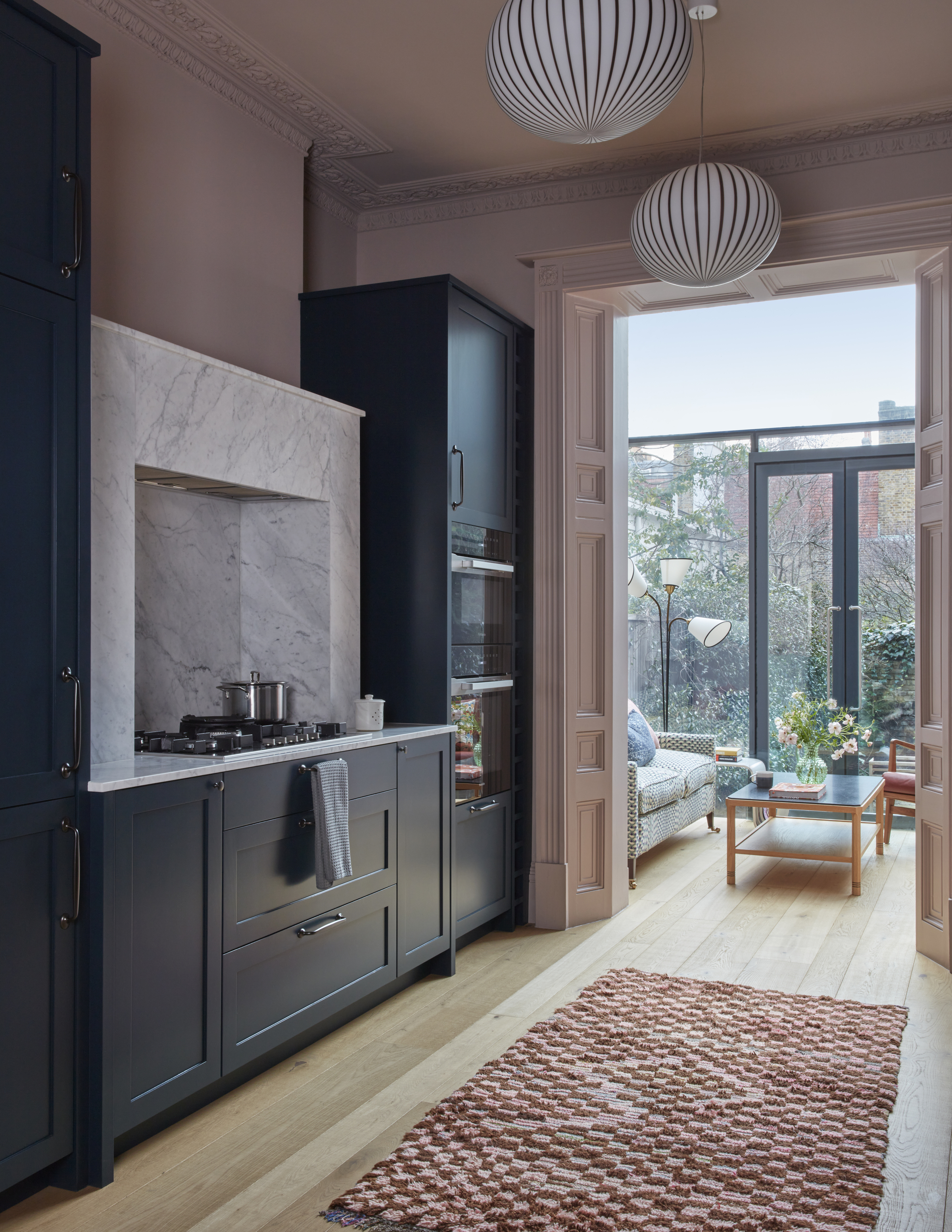
Have limited space and want to keep it clutter-free? A one wall kitchen might be your best bet. This layout is space-saving, cost-effective, and streamlined—delivering smooth workflow along with a clean, uncluttered aesthetic.
“This kitchen is open to a dining room on one side and a garden room on the other, and we didn’t want it to feel too kitchen-y,” shares Kate Guinness of Kate Guinness Design. “Instead, we wanted it to sit more comfortably between two flexible living spaces. Because the kitchen itself was quite small, we decided to break up the cabinetry into different styles. This helped the space feel less crowded while still delivering plenty of all-important storage.”
“The floor is a bespoke mixed-width design that we had made specifically for this project,” she adds. “We love mixed-width flooring partly because it’s a traditional technique. Before mass production, people used every part of a felled tree, so boards came in varying widths. For period properties, this feels especially fitting. Also, in long spaces like this—where the layout runs front to back—uniform boards can create a striped effect that draws the eye. We wanted the floor to be a quiet backdrop, allowing the view out back to take center stage. It also has a band-sawn finish, meaning it’s not completely smooth. That was a bonus for our client, who has two small dogs—perfectly smooth wood floors would be slippery for them, and their claws aren’t the kindest to polished surfaces.”
8. Enhance the Small Kitchen With Sleek Lighting

In a hardworking room, task lighting takes on an importance that’s hard to overstate. When it comes to kitchen lighting ideas, pendants or sconces get all the glory, and rightly so. These not only illuminate specific zones and corners but also give the room style and overall sparkle.
"Kitchens obviously need to work hard and so does the lighting," says Niki Wright of lights&lamps. "Recessed spotlights or under cabinet lighting is a common solution, but also consider the space when it’s not functional. Don’t be afraid to use ‘living room’ lighting in the kitchen: a pendant, a floor lamp in a corner, or a table lamp at the end of a countertop."
9. Consider Natural Materials for Small Spaces
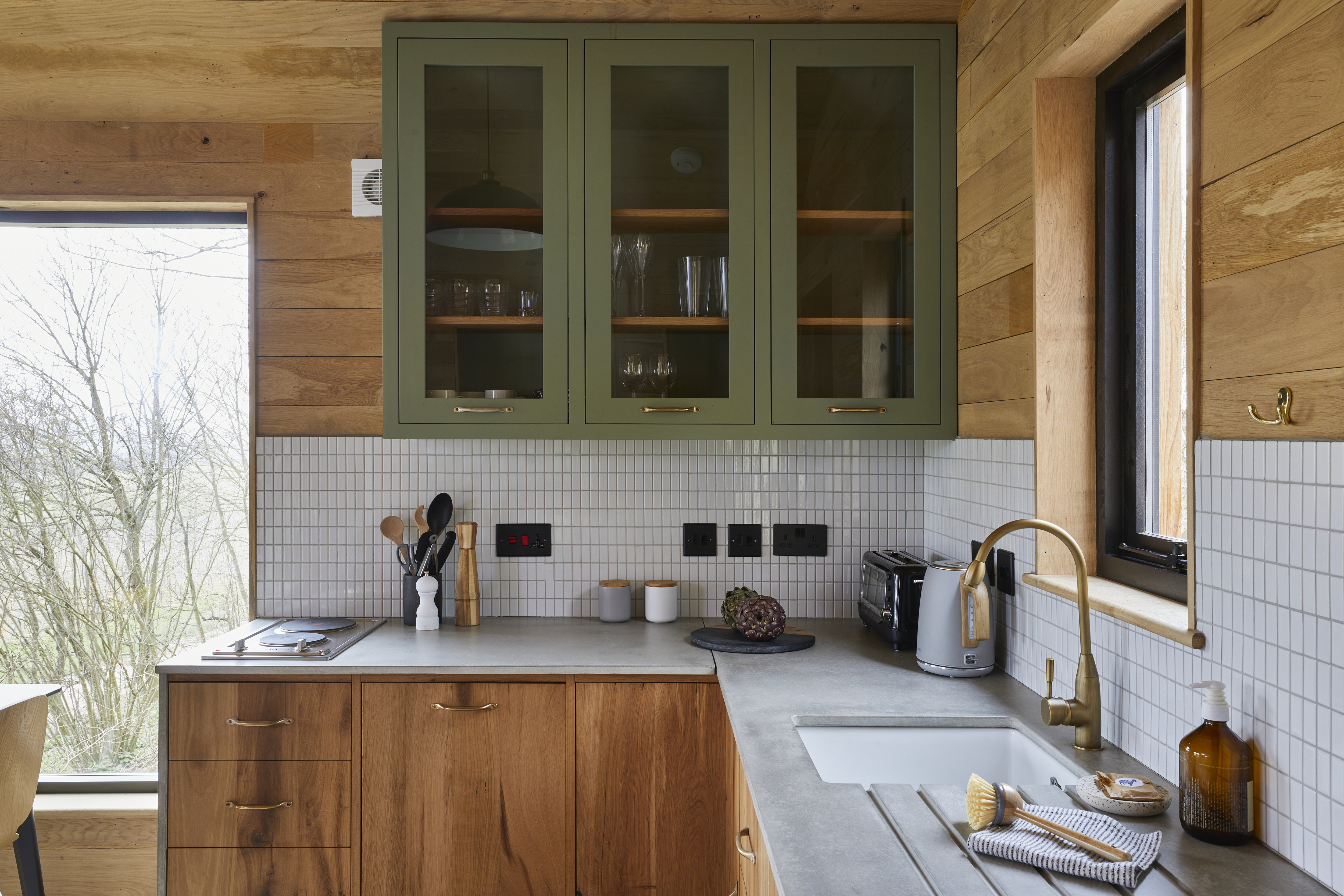
"We’re seeing many homeowners experimenting with texture, and the desire warmer and more tactile materials in the home," says Alex Main of The Main Company. This has given rise to more earthy, rustic kitchens.
"Whether this is in the form of a reclaimed element such as a wooden countertop or a crisp panel detail, clients are experimenting more and more and are looking for individual touches in their kitchens," adds Alex. "Reclaimed wood is increasingly popular thanks to its sustainable nature and visual appeal, with exquisite natural details which give a characterful, rustic aesthetic to a home."
10. Use the Same Backsplash and Counter
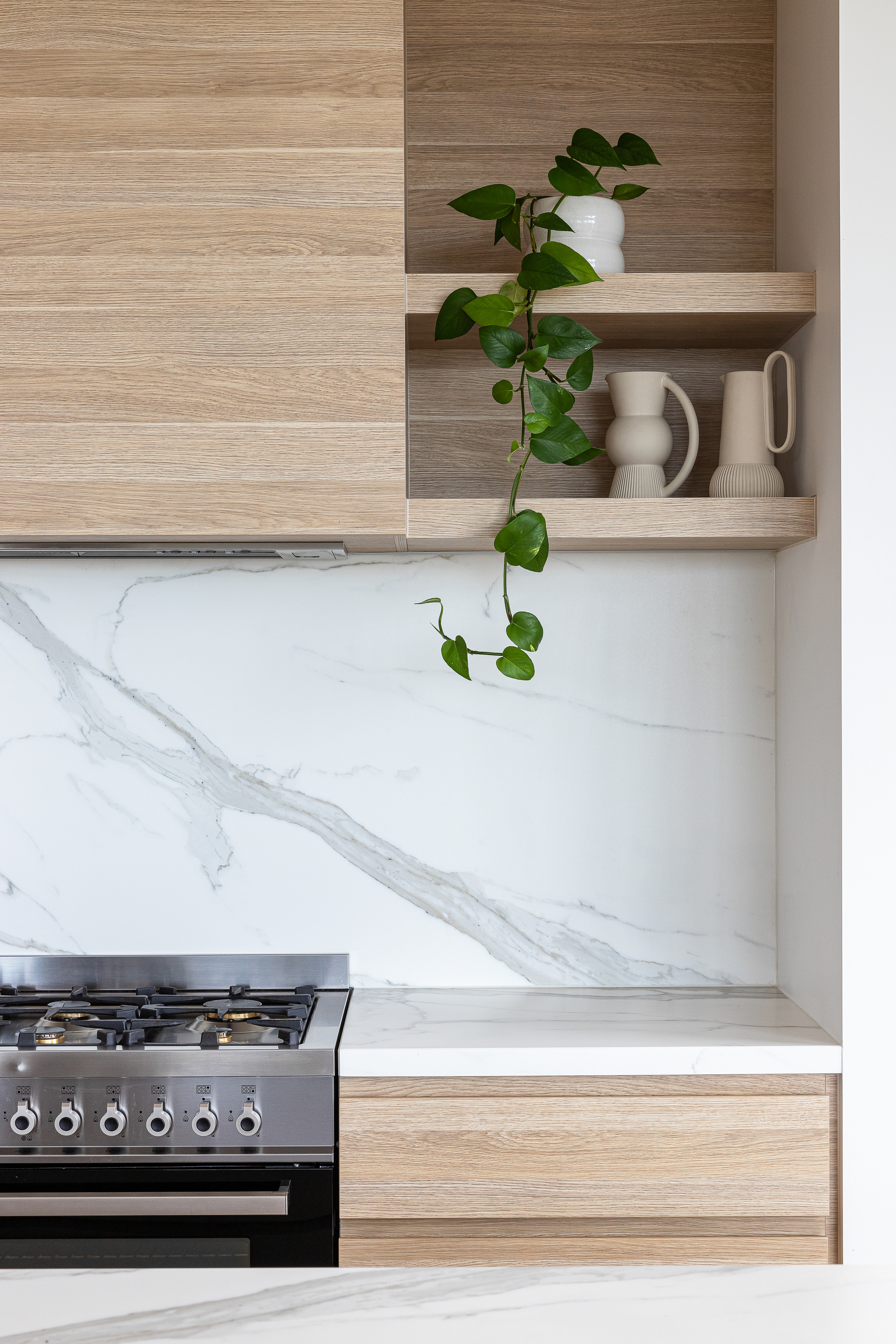
For a long time, marble kitchens have been considered the epitome of class, however, marble is an expensive and hard-to-maintain stone. Thankfully, there are several great alternatives out there that mimic the look of this natural stone yet give the kitchen a lasting charm.
"Manmade options aren’t as good as the real thing, however, the quartz equivalents are a respectable alternative and tend to be more hardwearing," says Alex. "Renowned for its quality finish and incredible versatility, these work across both traditional and modern kitchens alike. From countertops to backsplashes, there is a huge array of options out there to suit any style of kitchen."
11. Insert a Banquette Seating for a Two-in-One Space

"In smaller rooms where space is limited and furniture has to work harder, banquette seating can often be the practical solution that ties a space together to give it purpose and character," says Jennifer Hamilton of The Vawdrey House. "The benefit of this seating is that unlike a chair, the bench seat can be pushed directly up to the wall or the back of another piece of furniture without the need to leave room to pull the chair out from underneath the table. In addition, clever storage can be built into the banquette, be that in the form of lift up seats or pull out drawers."
Banquette seats offer a more informal, relaxed atmosphere in a room, and, importantly for homes that are tight for space, the lack of defined seats means that you have the flexibility to squeeze more people onto the table than you would with regular chairs.
"The banquette often becomes a focal point of a design scheme," says Jennifer. "By introducing fabrics and pillows onto the banquette, the seating area can take on softer more sofa-essque qualities which works particularly well in mixed use open plan rooms where the home owner plans to entertain and relax in a space as well as cook and eat. For families wishing to introduce banquettes, we like to recommend pleather seating which is wipe clean and practical while still giving off a luxury sitting room vibe."
12. Add an Island/Dining Table for Increased Functionality

You might not think it’s possible, but see how this small kitchen island works perfectly in a tiny space. Counter space is usually in short supply in small kitchens, so this is a great solution, especially if you can add a seating area, too – two problems solved.
"An uber-functional way to maximize space in a small kitchen is to integrate the prep island with the dining area," says Emilie Munroe, founder of Studio Munroe. "A continuous tabletop allows diners and chefs to easily interact during meal preparation and clean up. This layout also works well for parents so children can work on schoolwork and projects while adults prepare for mealtime."
13. Create a Moody Look with Dark Hues
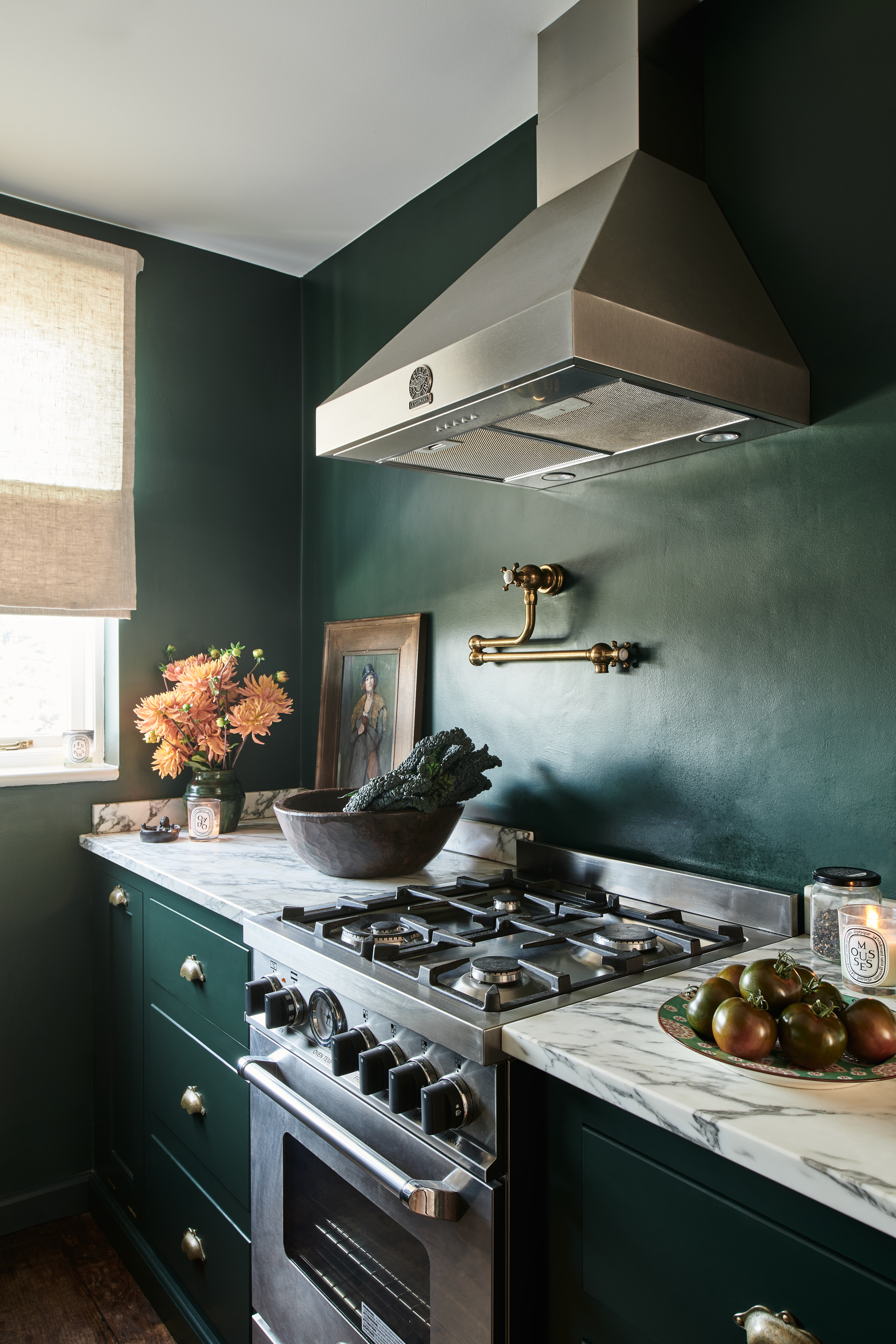
Who says dark kitchen colors aren't suitable for small spaces? Deep tones create a sense of depth and a feeling of infinity in a room. Plus, let's be honest. Dark tones look immediately arresting and dramatic. A look you want to give in this small yet extremely significant space.
"I think color is a completely personal choice and a decision that should be primarily based around the atmosphere you want to create, rather than trying to make a small room look big," says Helen Parker of deVOL. "However small a room is, if you want moody and atmospheric, then go dark or bold or busy."
14. Or Go for a Bright Color Scheme to Make a Small Kitchen Feel Larger
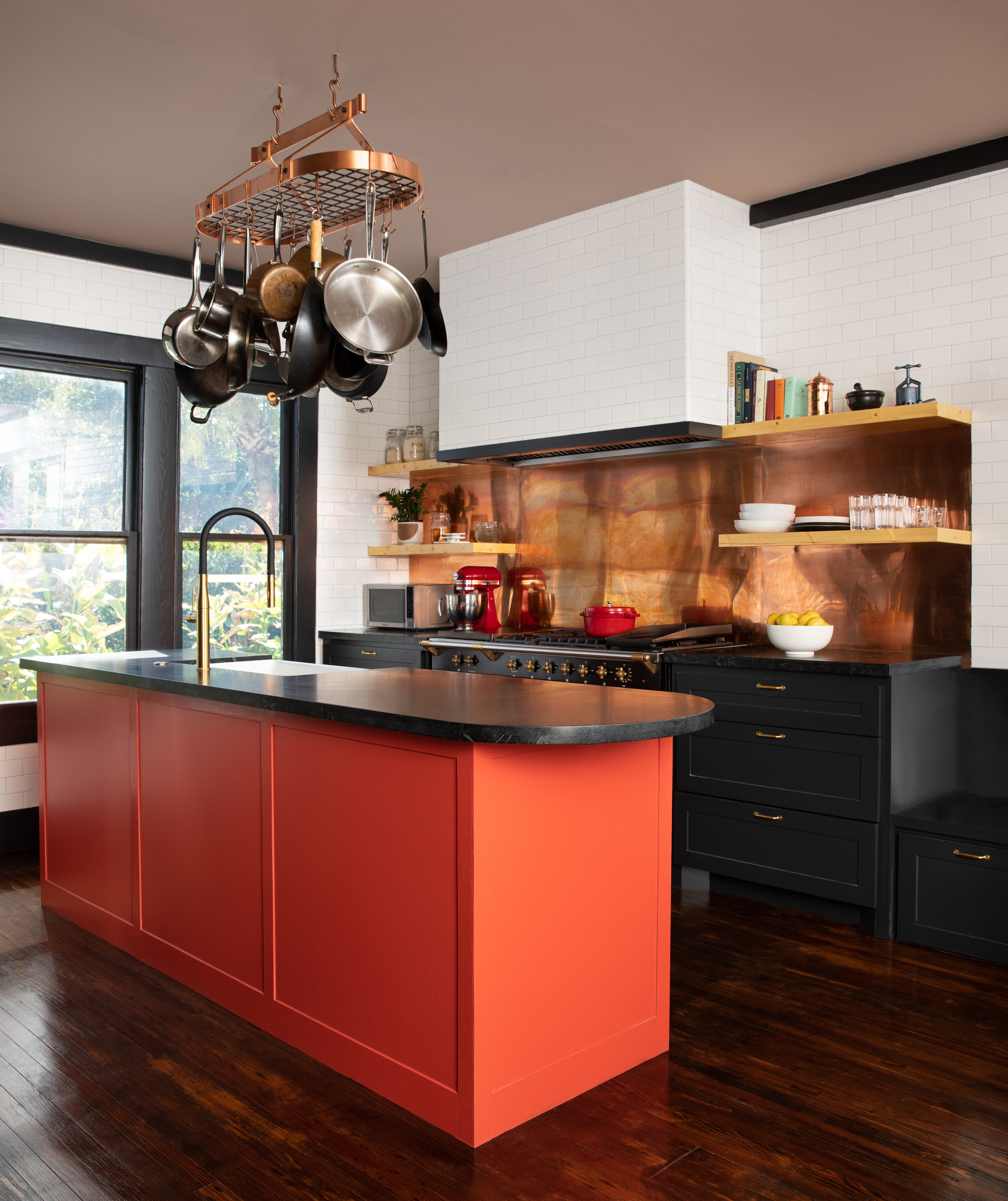
Contrary to popular belief, a small space deserves vibrant colors. And no, it doesn't make it seem smaller; in fact, a bright lick of paint will give the room personality and depth. If you're planning on remodeling a kitchen, pack a punch with a choice of a bold hue.
"Adding a pop of bright color to the center of a room with light walls can make the room appear larger," says interior designer Mary Patton. "In this project, the sunny island makes the copper backsplash shine and brings cheer and warmth to the room."
15. Avoid Wall Cupboards to Create a Sense of Space
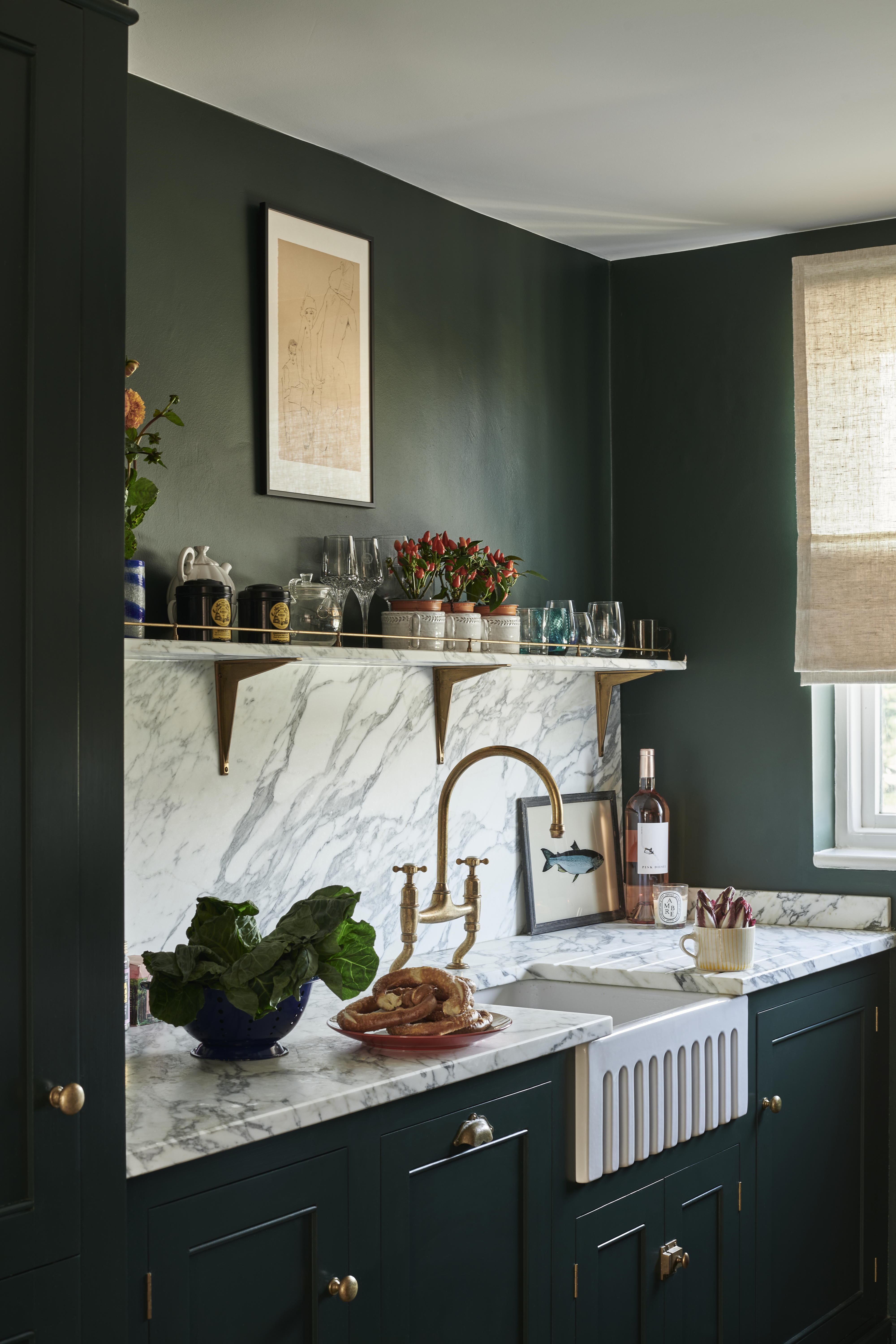
If you aim to make a small kitchen look bigger, then the best way to achieve this is by not filling the room with cupboards and leaving plenty of light and space around the windows.
"Avoid wall cupboards," says Helen. "It is also a good idea to keep the colors and materials similar, so soft light woods and flooring and similar color walls and cupboards work. This will have more of an impact than just painting your walls in a light color."
Also, while you're going in for a sleeker look, remember that protruding cabinet knobs and pulls can take up a lot of visual and physical space. Choose handleless kitchen cabinets with a lip or touch latch. This will give the space a seamless, minimal look without visual interruptions.
16. Go for Checkerboard Flooring to Distract Attention Away

Long stripes, geometric patterns, chevron prints, and even checkerboards can give your kitchen flooring a boost and even work as a wonderful diversion. As you enter the space, eye-catching floor tiles will generate immediate interest and make one forget to notice the small square footage of the area.
Plus, some patterns can create the illusion of extended space.
"The small kitchen comes alive with classic black and white harlequin floors and a beautiful marble backsplash," says Vinithra Amarnathan, founder of Weespaces. "A prep table with carved wood legs adds function and character."
17. Consider Pastels to Give the Kitchen a Soft Look
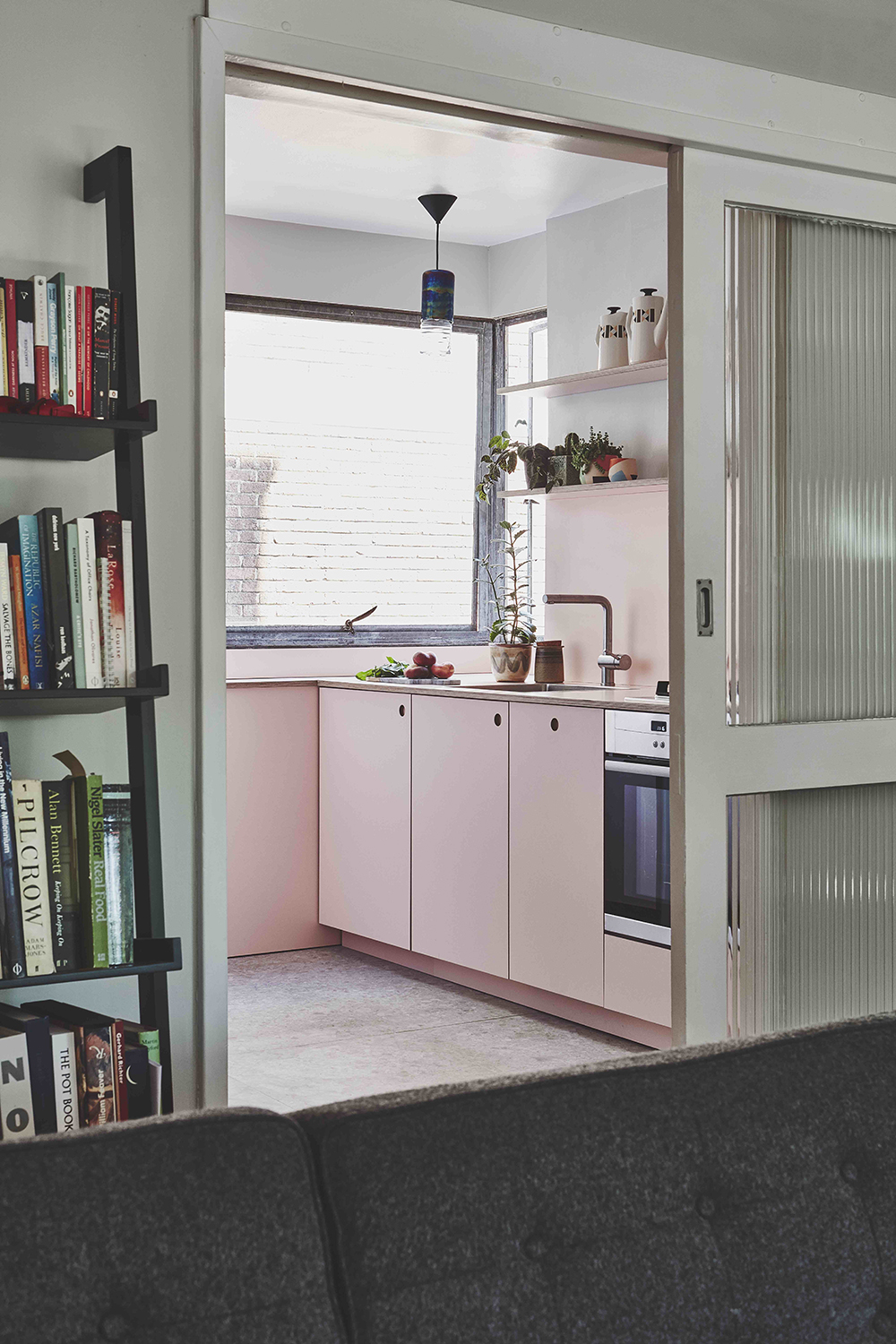
You'll be surprised at how much just mere color can do to make your small kitchen look bigger and better. Soft, neutral tones can create a feeling of lightness in the room, so the bulky drawers and cabinets look neat, clean, and visually light. Wondering what scheme would look modern and crisp? How about pastel kitchens?
"There is a plethora of smart ways to make your kitchen feel spacious," says Tom Howley, design director at the eponymous kitchen company. "To keep an open feel, choose light paint colors and reflective materials such as bright quartz or a mirrored backsplash."
Keeping the small kitchen paint colors in mind, ensure all storage is painted the same hue, as different colors can break the visual synchrony.
18. Hide All Appliances to Keep the Countertops Free
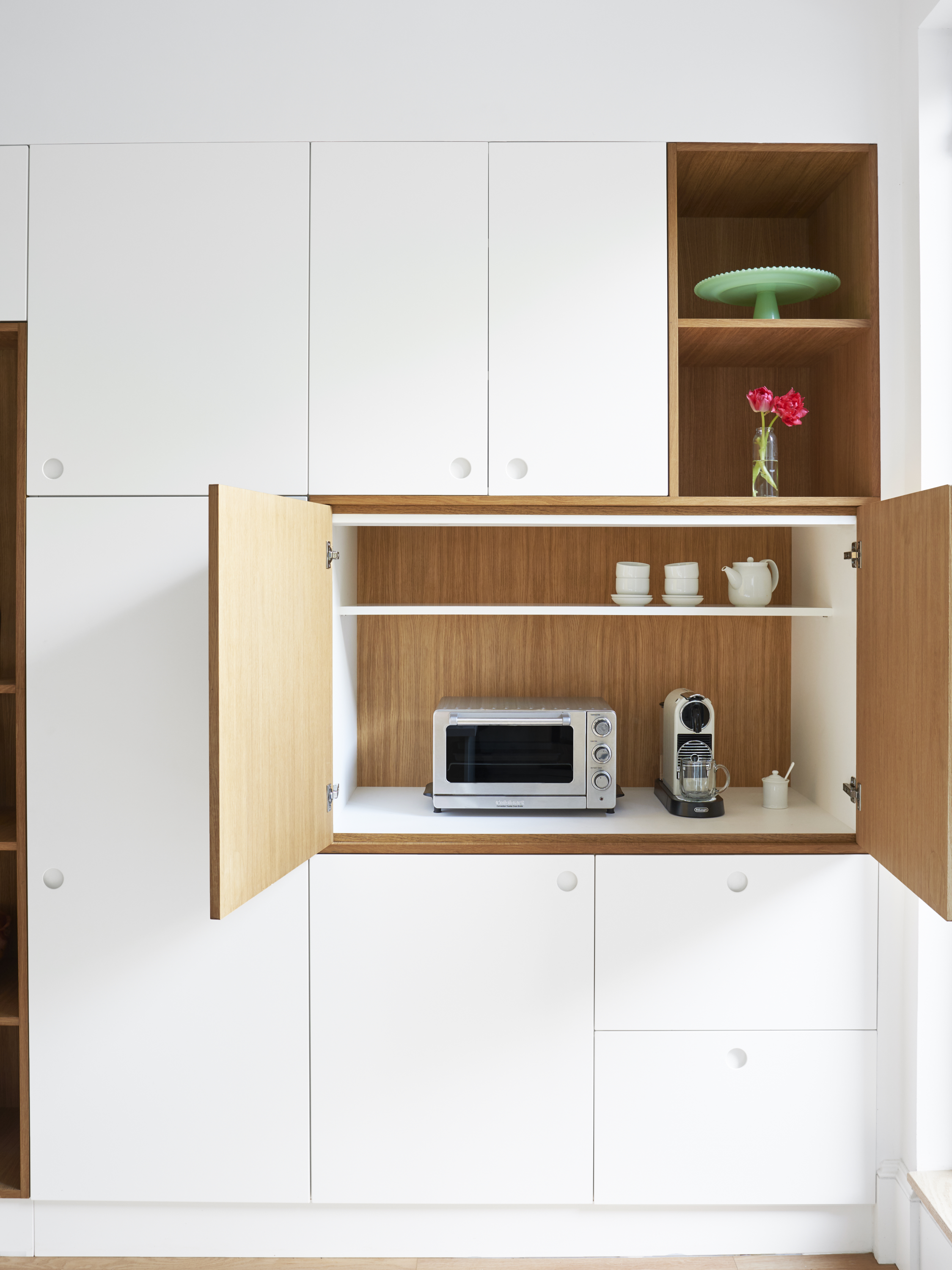
Clutter can visually contract the size of a space, especially an open plan kitchen where the room has several more elements adding to the busy vibe. Countertop elements, microwaves, blenders, and crockery can almost make the kitchen suffocating to look at. This is the reason why everything must be hidden away.
"Space is at a premium inside small apartment kitchens, but an easy fix is keeping countertops free of appliances and storage," says Ming Thompson, principal architect at Atelier Cho Thompson. "If possible, keep larger appliances like stand mixers in cabinets until needed."
"For larger, more frequently used appliances like microwaves, you can take a cue from contemporary kitchen designs and try to place these within cabinets, even removing doors to make a simple appliance hutch," says Ming.
19. Ensure Multiple Storage Options in Your Tiny Kitchen

You need to be brutal with clutter in a small kitchen; don’t buy more than you need in terms of cookware and gadgets, which take up a lot of space, especially on the worktop.
As far as kitchen updates go, drawers are essential and offer multiple storage options, especially deep drawers with cutlery or utensil inserts in the top part. Tall, thin larder units can fit into the gaps between units and are great for storing food and spices.
20. Utilize the Entire Length and Breath of the Room
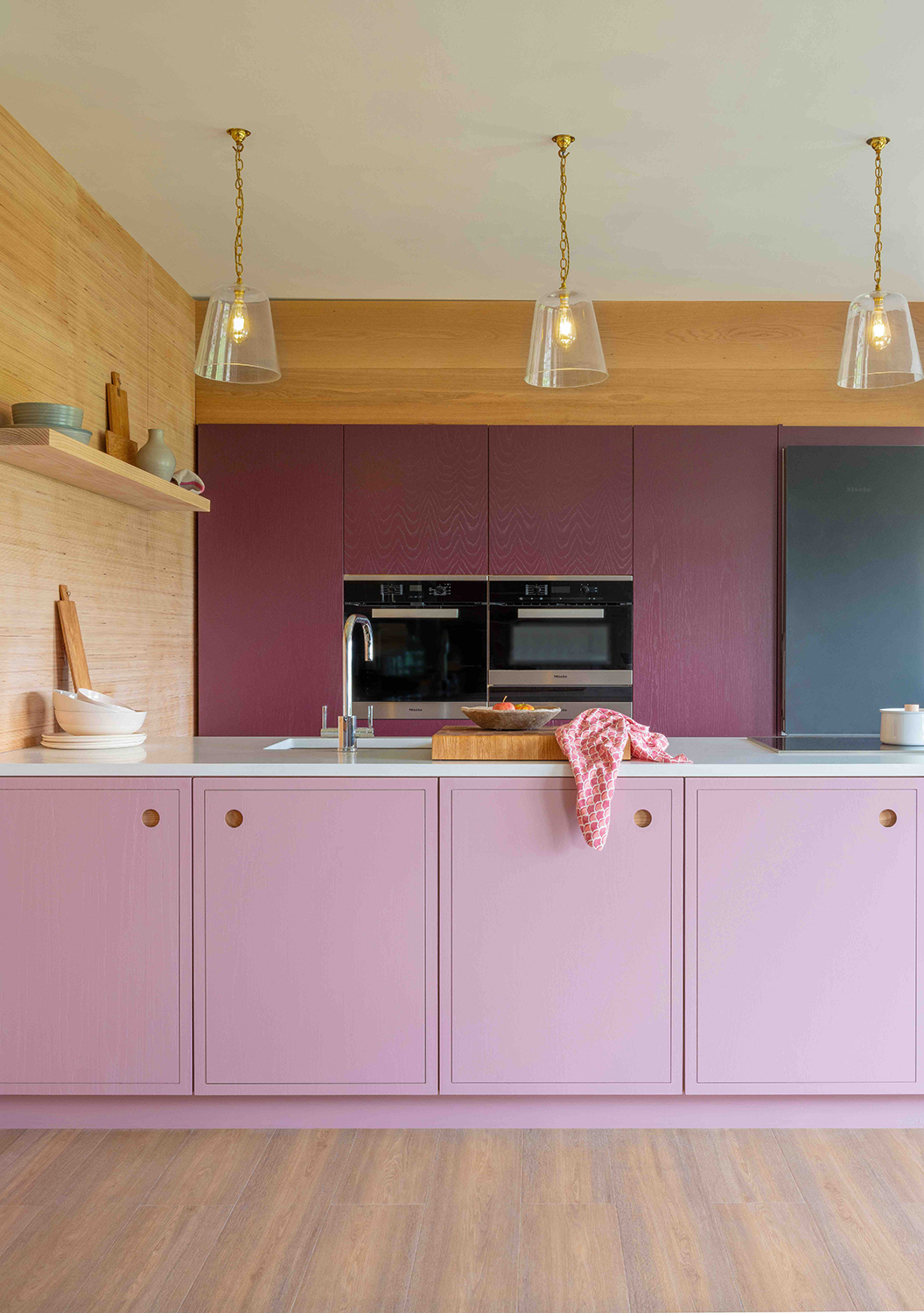
To boost kitchen storage, don't only look to the walls and the floor — look up, towards the entire length and breadth of the room. After all, in skinny spaces, every single inch counts.
Bring in a standard 12- to 16-inch cabinets above the counter so you have enough breathing room at your elbow height. Choose deep cabinets to stash large items or seasonal pieces.
"Utilize every inch of space from the full height and awkward nooks," says Ming. "Take the storage up; it will benefit your kitchen by ensuring more storage."
Consider installing a multipurpose unit in your floor-to-wall storage. Add a pull-out chopping station, complete with a chopping-block top in it. You could add a fresh set of drawers so you have everything you need tucked away.
21. Trick the Eyes With a Patterned Backsplash
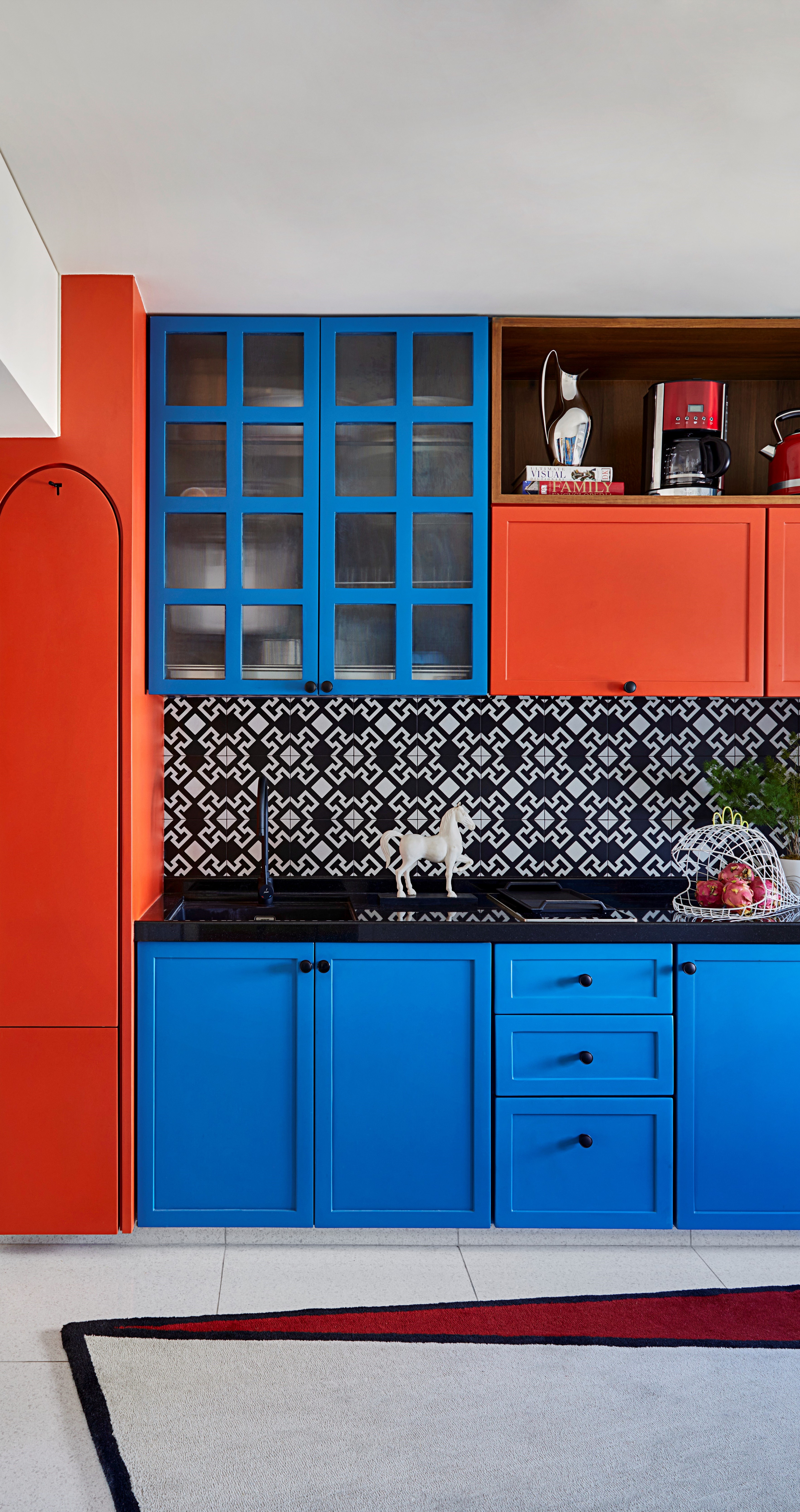
Pattern used for a kitchen backsplash can make a smaller scale space appear bigger. That's because big designs distract the eye away from the small square footage and onto the pretty patterns.
"For small kitchens, I recommend patterned tiles with no more than two colors, one being neutral to not overwhelm the space," says Damla Turgut, founder of Otto Tiles. "A single tile that encompasses a whole pattern such as a grid, pyramid, or herringbone design, rather than a tile which needs 4-6 tiles to make up a design, is ideal for a small kitchen making the space appear visually larger, by tricking the eye."
22. Use One Tone Throughout

Ideally, in a small kitchen, the fewer visual obstructions, the better. By blurring lines and keeping the same color tone between countertops and cabinets, you can create the illusion of extended space. The best, most timeless kitchen cabinet and countertop combination is a muted tone; perhaps white, beige, or gray.
"Light and muted countertops work brilliantly in smaller kitchens as they naturally reflect light into the room," says Julia Trendell of Benchmarx Kitchen and Joinery. "Blurring the lines of where the counter ends and the wall starts is another great trick for making a kitchen feel larger. Continue a granite or quartz worktop up the wall as a splashback or upstand to give the illusion of more space with minimum hassle," says Julia.
A great tip to keep in mind is that the upper cabinets should start at the height of your hood as compared to cabinets at one height and the hood at another. This will create a tidier look with clean lines. Ensure your cabinets start about 20 inches above the counter, although you could start them a little higher (24 to 30 inches) to feel a lot less boxed in as you work at the counter below.
23. Go Handleless for a Sleek Look

Small kitchens can quickly look cluttered, so keep detailing to a minimum and avoid the shaker style. Handleless cabinets will not only create a lovely, minimalist kitchen but also make it feel larger, lighter, and airier.
There's a wide range of finishes to choose from, including the modern glossy white of these units, chosen by interior designer Gillian Segal.
If you need handles, choose integrated grooves instead of attached hardware to give the kitchen a modern look and save a precious few inches of room. This will also encourage you to not hang your kitchen towels or bump your knees on knobs or pulls while moving around.
24. Light Up Dark Corners for a Bright Small Kitchen Design
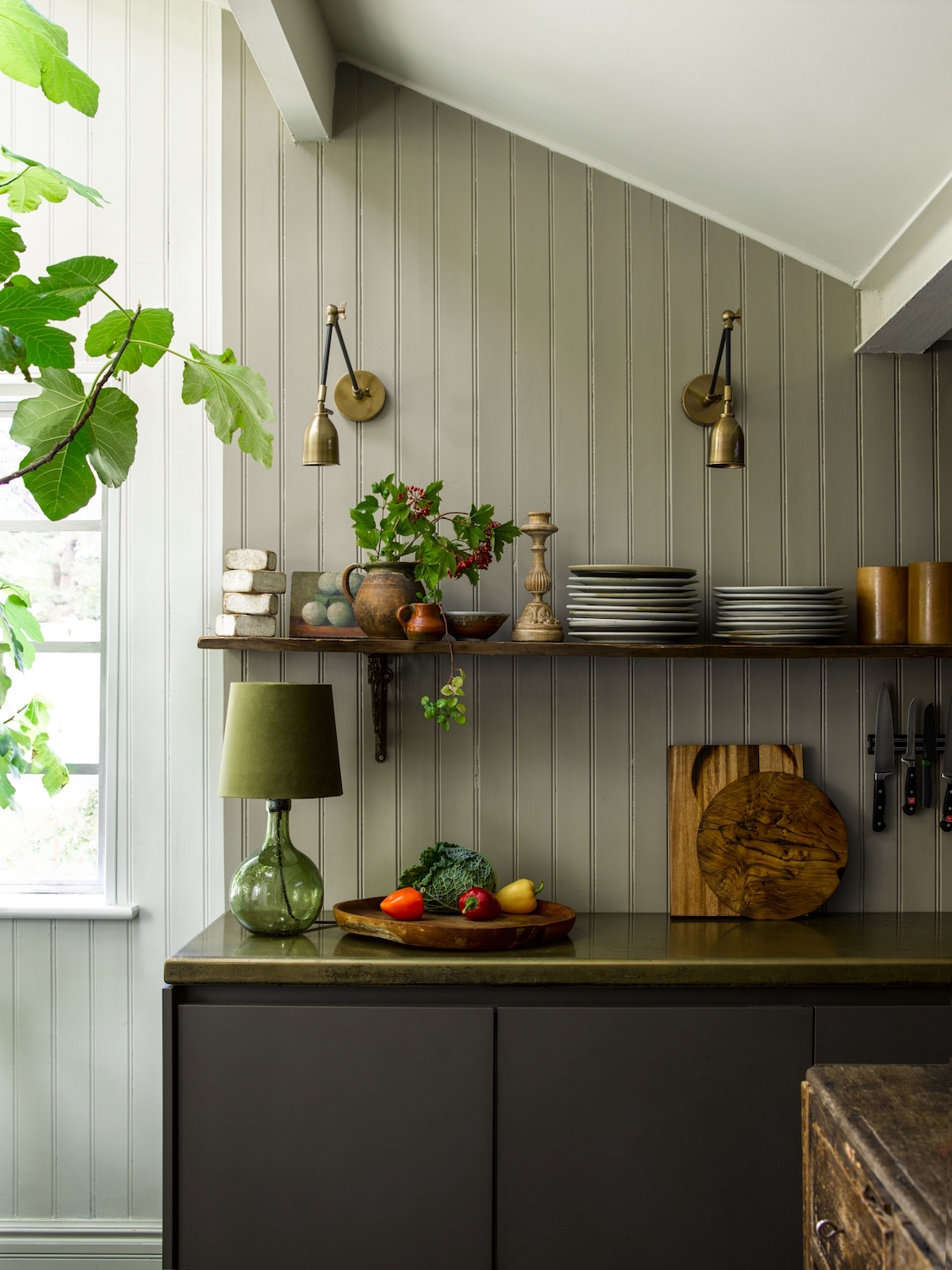
When it comes to small kitchen lighting ideas, Rohan Blacker of Pooky, suggests installing downlights or LED strip lighting in the recesses of your cabinets.
"They're great at highlighting darker corners and will open up your space," he says. "Use lighting to highlight certain features in your kitchen that may be hidden in the shadows of overhanging cabinets, be it your new red toaster or a statement tiled backsplash."
25. Choose the Right Layout for a Small Kitchen
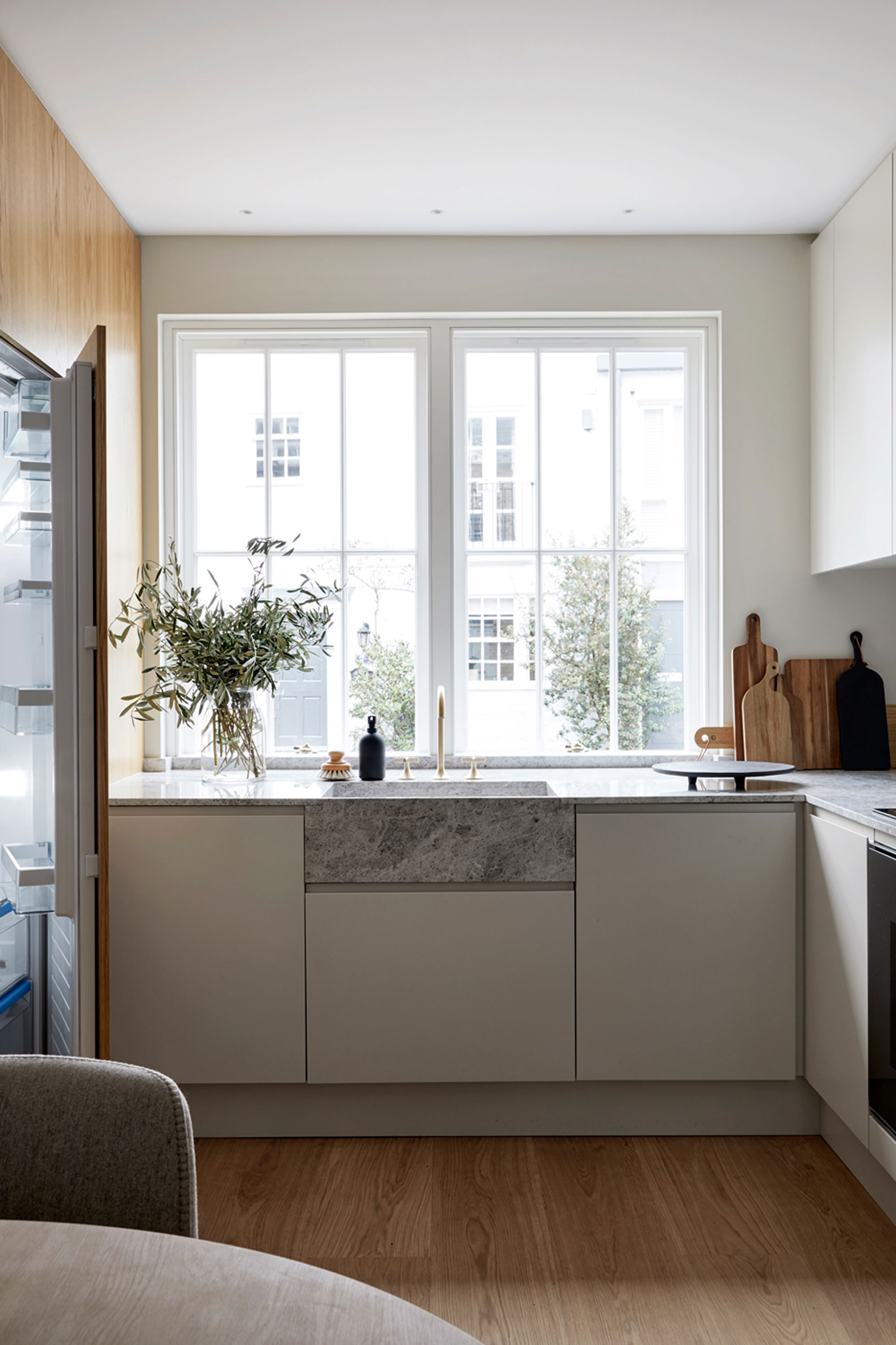
There are several to choose from: U-shaped, L-shaped kitchens, galley kitchens to open plans. Ideally, a U-shaped kitchen has great ergonomics, as it's the right distance between the three main points of the space — the fridge, sink, and stove — and makes for the best kitchen work triangle. It makes it easier to walk between these points during meal prep and reduces cooking time.
Most kitchens benefit from an island but if you don't have space for one, even a cart on wheels or a pull-out counter can help to a great extent. If you wish to have a breakfast counter in your small kitchen, choose seats that tuck under the countertop, thereby saving precious floor room.
26. Use Cabinet Organizers to Keep a Small Kitchen Clutter-free
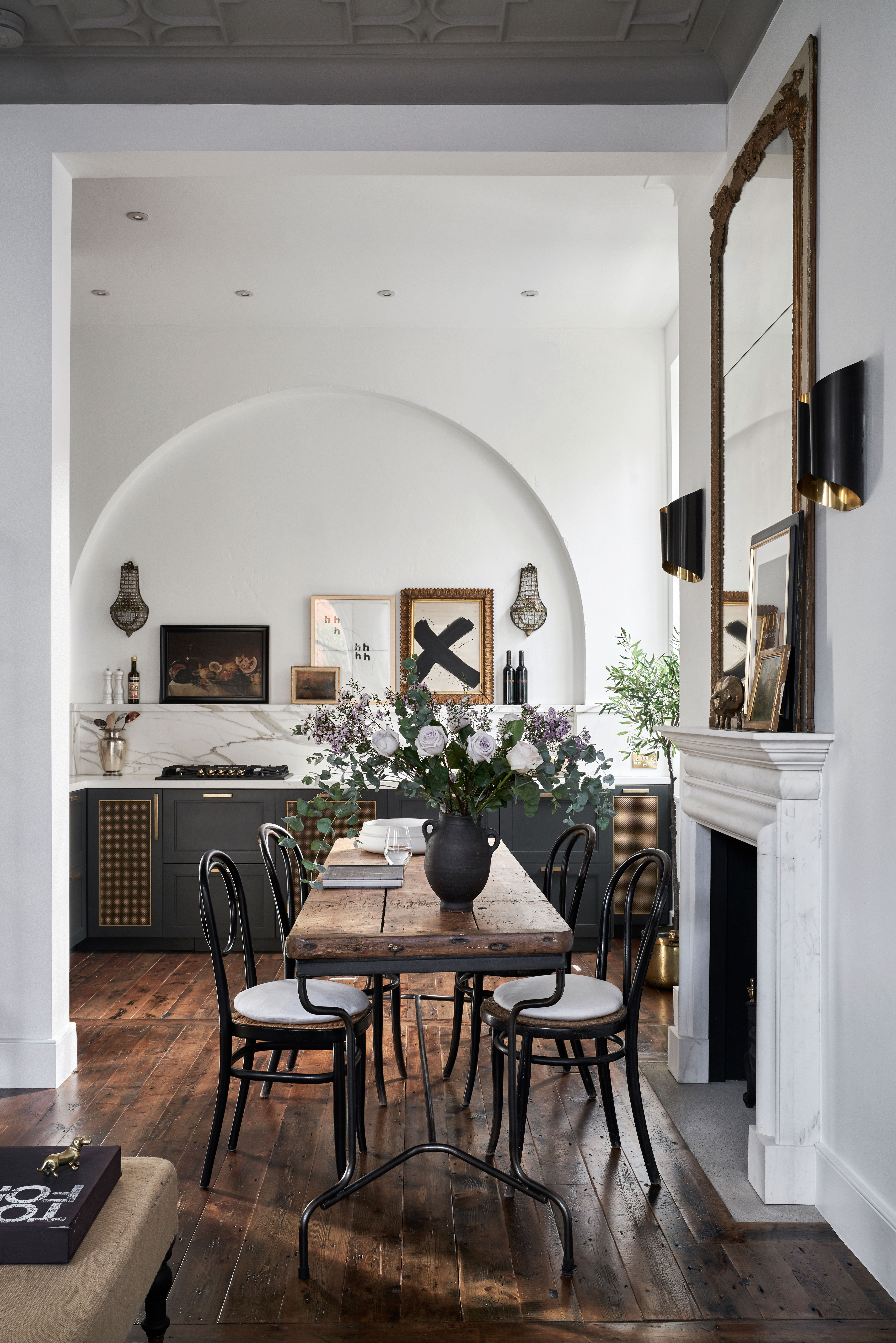
Cabinet organizers can be extremely useful to store knives and forks and ensure these small items don't clutter the kitchen. Consider breaking up your drawers into compartments so you can store more things effectively and learn the basics of how to organize a kitchen.
Most importantly, if your kitchen is mini, consider a good edit of your paraphernalia. Think hard: do you really need more than a handful of plates, mugs, or glasses if there are just two members in the house? Owning fewer things can be immensely freeing and will significantly make your life easier and smoother.
FAQs
What Do I Do If My Kitchen Is too Small?
If your kitchen feels too small, focus on smart storage and layout solutions to make the most of every inch. Go for vertical storage—think floor-to-ceiling cabinets or open shelves above counters. Use pull-out drawers, corner units, and hidden compartments to keep clutter at bay. A galley or one-wall layout can streamline workflow in tight spaces.
To enhance the design, choose light colors, reflective surfaces, and under-cabinet lighting. Add character with bold hardware, statement backsplashes, or patterned floors. With the right approach, even the smallest kitchen can feel stylish and surprisingly spacious.
How Can I Make the Most Out of My Small Kitchen?
While thinking of small kitchens, whether it's an apartment kitchen or narrow gallery spaces, there are a few that could work very well.
A great way to maximize space in your tiny kitchen and to make it look organized is to choose a clean, neutral color scheme that makes everything look neat. Choosing similar tones for countertops and cabinets can blur the lines between spaces, giving the kitchen a seamless look.
Choose handless cabinets, hide all appliances inside storage units, and keep all cutlery inside drawers. If you have a little more floor space, consider adding an island that will increase storage and countertop space. If you have a skinny kitchen, bring in carts that can be wheeled in and out of the room.
Use the entire height of the room to increase storage. Ensure all your cabinets are well-lit so that no area or corner of the room is dipped in darkness. You'll be surprised how much you can open up the small kitchen just with effective lighting.
Finally, use large patterns in unexpected spaces to give the illusion of expanded space. Hang a mirror on one of the walls for more space-boosting tricks.
How Should Pots and Pans Be Stored in a Small Kitchen?
Pots and pans make up the majority of kitchen accessories, and storing these efficiently is of utmost importance. These can, at times, be challenging to store because of their size and bulk.
If you don't mind your cookware being on display, use the magic of wall hooks or pegboards to hang them for a tidy countertop. You can even add these hooks behind doors, if not the walls, so the pans are somewhat out of sight. You could choose a smart pot rack and suspend it over an island or peninsula. Make sure it is mounted high enough that it doesn't come in your way nor is it in your line of sight.
Another neat way to store your pots and pans is by installing a shelf right above the range. You will want to keep your daily use vessels here so they are easy to reach and re-rack.
A pull-out rack inside a deep drawer is effective if you don't want your cookware to be visible. You can add an easy Susan or even hooks to keep the pots.
In small city homes, it’s a given that the kitchen won’t be a large, lavish space. But as designers often point out, there are plenty of smart ways to maximize its potential through thoughtful storage solutions and clever layouts. With the right colors, materials, and accessories, this compact area can even become the home’s standout “design corner.” So, get inspired to create the most stylish and efficient small kitchen possible!







